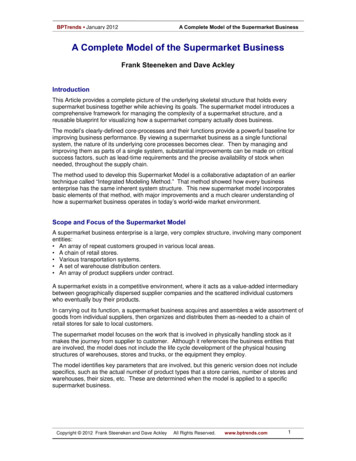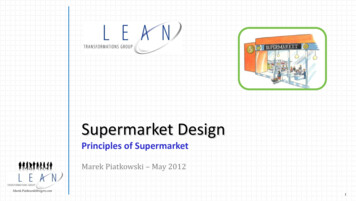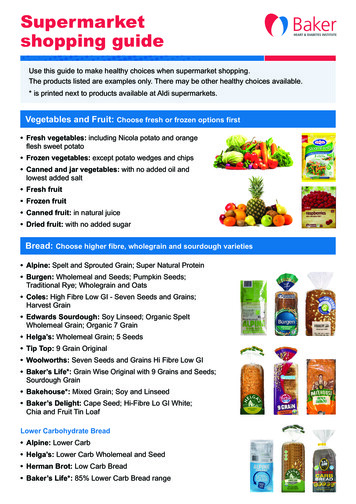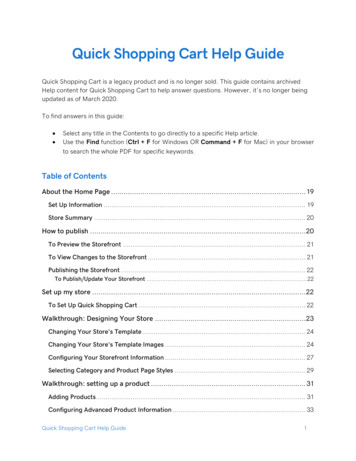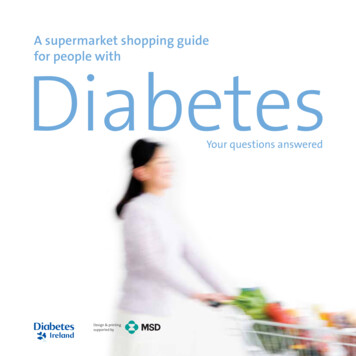
Transcription
A supermarket shopping guidefor people withDiabetesYour questions answeredDesign & printingsupported by
Who is this booklet for?While this booklet is mainlyintended for people with diabetes,their families or carers, it is a healthyeating guide suitable for everyone.It is important for us all to be awareof different types of foods and howmuch of them we eat.This booklet is intended to be apractical guide to help you followa healthy lifestyle. The informationprovided is suitable for the wholefamily. We hope that the guide willmake shopping easier, and moreenjoyable, and help you in makinghealthier food choices.
ContentsDiabetes explained5Supermarket shopping—the ‘how to’11Dietary considerations—salt, alcohol and food labels25Putting it all together, meal suggestions and recipes37References and Acknowledgements54
DisclaimerOur recipes contain nutritional informationwhich should be used as a guide only. This isbecause of differences in ingredients thatoccur naturally, how you might cook the recipeyourself and the size of the portion you eat.Nutritional analysis gives total carbohydratefor the ingredients used. Remember to look attotal carbohydrate per serving, not just‘of which sugars’. If additional carbohydrateis taken or suggested to be served with,remember this must be added to theoverall carbohydrate content of the meal.The nutritional information was calculatedby a Diabetes Ireland dietitian using theMicrodiet package.
Diabetes explained5
What is diabetes?Diabetes mellitus or diabetes, is a conditionwhere the blood glucose sugar levels are toohigh. Glucose levels are controlled by thehormone insulin. People with diabetes eitherhave a lack of insulin, or the insulin which isproduced isn’t working properly. This resultsin the body being unable to use the bloodglucose as it should. There are many medicaltreatments for diabetes, but we mustremember a healthy lifestyle is thebackbone of all treatments.How prevalent is diabetes?Worldwide, diabetes affects roughly 340million people. Diabetes is more commonin certain population groups – namelyAfrican, Caribbean and South Asian. Thereare approximately 225,000 people living withdiabetes in Ireland, and many more livingwith the condition but do not yet know it(undiagnosed). Many more are at high riskof developing type 2 diabetes unless theychange to a more healthy lifestyle.6
What are the different types of diabetes?There are two main types of diabetesType 1 diabetes tends to occur inType 2 diabetes usually developschildhood or early adult life, and alwaysslowly in adulthood, with riskrequires treatment with insulin – eitherincreasing over the age of 40. It isby injections, or pump therapy.progressive and can sometimes beDevelopment of type 1 diabetes istreated with diet and exercise, butunrelated to poor lifestyle habits.more often type 2 diabetes mayType 1 diabetes is caused by the body’srequire diabetes medications and/orown immune system destroying theinsulin injections to keep the bloodinsulin-making cells (beta-cells) of theglucose under control.pancreas. The reason why this happensis unclear, but may include factorssuch as genetics, viral infection andthe environment.Whether a person has type 1 or type 2 diabetes, a healthy balanced diet will help control thecondition successfully in combination with regular activity, maintenance of a healthy bodyweight and taking medications as prescribed.7
When a person without diabetes eats a mealThe gastrointestinal tract breakscarbohydrate foods down intosimple sugars called glucose,which it then absorbs. It alsoreleases incretin hormones12The incretin hormonestell the pancreas torelease insulin4Glucose travels throughthe blood vessels to3the body’s cellsThe body tells the liverto stop making glucose5The kidneys function normally– filtering blood and removingwaste. Normally the urineproduced by the kidneys doesnot contain any glucose86Insulin helps glucoseget into the cells
When a person with diabetes eats a mealThe gastrointestinal tract breakscarbohydrate foods downinto simple sugars called glucose,which it then absorbs. There maybe fewer incretin hormones to tellyour pancreas to make insulinafter a meal – and some of thosehormones that send themessage don’t work as well312Your pancreas no longermakes enough insulin –so it works even harderto try to keep up4Too much glucosebuilds up in your bloodYour liver keepsmaking glucose5It’s harderfor glucoseto enteryour cells6Your kidneys try to get ridof the excess glucose in yourblood. If there is too muchglucose in the urine, you mayurinate frequently and needto drink more fluids9
Will my diabetes limit the types offood I can eat now?Why is seeing a dietitian important?The ideal shopping list for a person with dia-Irish Nutrition & Dietetic Institute (INDI – seebetes is the same as a shopping list for anyonewww.indi.ie) can give you individually tailoredwanting to eat a healthy balanced diet – that isadvice for your diabetes. He/she will takemostly fresh unprocessed foods, which are lowinto account your medication, any additionalin fat and sugar, moderate in starchy carbohy-medical conditions you may have, your weight,drates, and high in fibre, vitamins and minerals.current dietary intake, among other factors.An easy rule of thumb is ‘the lessprocessed, the better’.Your dietitian can guide you to make healthyA healthy diet contains a balance of the 3 mainany other diet related queries you have aboutnutrients – proteins, fats and carbohydrates.your diabetes.Eating regular meals will make it easier foryour body to control your blood glucose. Sometreatments require attention to be paid to thetiming of meals, whereas others are less strict –talk to your dietitian or diabetes care teamto see how flexible you can be with yourmeal plans.10Your dietitian, who should be a member of thefood choices, educate around portion sizes offoods (especially carbohydrates), and answerEating well can improve yourblood glucose control, and reducesthe risk of developing long-termcomplications associated withdiabetes, such as heart disease.
Supermarket shopping—the ‘how to’11
Foods to look out for in the supermarketSupermarket shopping can be an overwhelming task at the best of times, so when you’veto think diabetes as well, the weekly shop canseem huge! Thankfully, this doesn’t need to bethe case – read on to learn how to make themost out of your visit to the supermarket.Before you shop, write a list. Check what isalready in your cupboard at home, and makea rough plan of ingredients you will need formeals for the week ahead. Some people findapps for smartphones useful for planning theirshopping – examples are ‘Mealboard’, ‘Pepperplate’ and ‘Food Planner App’. Planning aheadmeans you are more likely to fill up the trolleywith foods you really need.At the back of this booklet, you will find somemeal suggestions, all of which are based onhealthy food choices.At the supermarket, you should find you shopby mostly using the perimeter of the storewhere the least processed food is available.Then still using your list, strategically tacklethe centre aisles. Read on for more details!12
Usually, up first are the fruits & vegetablesThink about including fruit with cereal, asa snack, or after a meal. Choose from fresh,frozen, dried, or tinned (in fruit juice, notsyrup). Vegetables can be steamed, roastedor made into salads – include a variety to keepWhat’s a portion? 1 medium sized fruit – an apple,orange, pear, small bananayour meals interesting. 2 small fruit e.g. kiwi, mandarinTo supplement your fresh purchases, stock up S mall handful of small fruit e.g.on frozen vegetables that are cut and ready tocook – frozen peas, green beans, and spinachwill cook in just a few minutes. There’s noexcuse not to have vegetables with dinner!Aim to eat at least 5 portions (in total) of fruitsand vegetables daily. They are low in calo-grapes, berries 1 slice large fruit e.g. melon,pineapple 1 small glass fruit juice or fruitsmoothie (100ml)ries, and their fibre helps keep hunger at bay, 4 dessert spoons of cooked freshand also slows down release of glucose intofruit, fruit tinned in own juice orthe blood stream, thus helping your diabetesfrozen fruitcontrol. Buying in season and availing of specialoffers will help to keep costs down.Remember, fruits contain naturallyoccurring sugars and may cause yourblood glucose to rise if eaten in largeamounts – so spread your fruitportions out across the day. 4 dessert spoons cooked vegetables 1 small bowl of salad 1 bowl of homemade vegetable soup13
The bakeryEven local supermarkets, tend to have displaysof baked goods, cleverly placed to tempt you.This is where your shopping list can be yoursecret weapon!Stock up on starchy carbohydrates. Starchycarbohydrates include all types of breads andcrackers, cereals, potatoes, pasta, rice andnoodles. These foods should be included ateach meal.Choosing oat based and wholegrain varietiesof starchy carbohydrates will help increase thefibre content of your diet, which in turn canhelp towards maintaining a healthy gut.Foods based on oats and wholegrains areChoose: Wholegrain breads Wholegrain cereals Wholemeal or seeded pitta pockets/wraps/bagels. Oatcakes, wholegrain crackers ‘Kids’ size wraps14released more slowly into our bloodstream,improving blood glucose control.Remember: the total amount ofcarbohydrate you eat is importanttoo – see the food pyramid on theback cover of this booklet andnutrition factsheets at www.indi.iefor guidance on portion sizes.
Don’t forget dairyDairy foods contain the naturally occurringsugar lactose.Top tips:To meet your calcium needs and keep bones C hoose low fat or skimmed milkshealthy, aim for 3 servings of dairy per day.Women who are pregnant or breast feedingalso need 3 servings daily, whereas childrenaged 9-18 need 5 servings a day.Choose low fat milk. Low fat milk has the L ook for reduced fat cheese K now your portion sizes – see thefood pyramid on the back cover flap T ry not to buy too much – even thevitamins and minerals we need for bone health,reduced fat varieties of cheese have abut does not have the saturated fat which cansignificant fat contentraise cholesterol. Low fat milk is suitable forchildren over the age of 2, and skimmed milk issuitable for children over the age of 5. C hoose yoghurts which say diet, ‘fatfree’, 0% or natural. These are low infat and sugar, and have little effect onblood glucose15
Meat CounterMeat and poultry are protein foods, so don’taffect blood glucose. Choose lean cuts ofmeats to reduce saturated fat intake. Askyour butcher to trim excess fat and skin offyour meat and poultry. Cheaper cuts of meatare a budget shopper’s friend – they areideal for soups, stews and casseroles. Askyour butcher for advice.Find the fishSausages and puddings have a high fat contentOily fish like salmon, trout and mackerel are– even when grilled, so keep these foods forrich in heart healthy omega-3 fatty acids.occasional treats.People with type 2 diabetes are recommendedRemember that stuffing or sauce will have alot of salt, and usually some carbohydrate too,so go for plain undressed meat or poultry andto have oily fish twice a week. Cod, hake, plaiceare all healthy options too, so try and includethese fish once as week as well.have a small amount of sauce on the sideMany supermarkets now stock uncoatedif desired.frozen fish – look for fish fillets without breadcrumb or batter coatings. See recipe ideasat www.diabetes.ie if you need help withmeal ideas!And, keep a supply of tinned salmon, tuna,mackerel or sardines in your cupboard to useas the basis of a quick and tasty healthy meal.When choosing tinned fish opt for ones tinnedin water, brine or tomato sauce instead of oilor mayonnaise.16
Salad bar and Deli countersThese are a minefield! Salads are often dressedin either mayonnaise or vinaigrette, and tendto be high in calories. Try to choose saladwithout dressing where possible, and avoidpotato salad and coleslaw. At home, whynot try dressings made with low fat naturalyoghurt, lemon juice and herbs, Frenchvinaigrette made with olive or rapeseedoil, or simply use a small amount ofbalsamic vinegar to jazz up agreen salad.17
DrinksIt is recommended to drink up to 2 litres (closeto 4 pints) of fluid daily. Drinks such as water, coffee, tea, and herbalteas are all fine, but do not add sugar. Artificial sweeteners can also be used in foods anddrinks – they won’t raise blood glucose.Examples are Canderel, Hermesetas,Stevia, Splenda, and many supermarketsnow have their own brand versions whichare also suitable. Avoid high sugar drinks such as fizzy drinks,energy and sports drinks. Fizzy drinks labelledDiet, Zero and Free, and no added sugarsquash are suitable alternatives.Fruit juice and fruit smoothies areconcentrated sources of naturalsugars, so need to be used sparinglyas they can have a significant impacton our blood glucose. The suggestedserving size is 100ml, and preferablythese drinks should be takenat mealtimes.Do I need to limit mycaffeine intake?The main sources of caffeine are coffee,tea, cola drinks, and energy drinks. Smalleramounts are found in chocolate and chocolateflavoured desserts. And, some oral medicationsmay contain caffeine too – cold and flu tablets,pain relief tablets, anti-histamines, anddiuretics (water tablets).Caffeine only appears to cause problems if alarge amount is taken. So having only a fewcups of tea or coffee each day, generally shouldnot be harmful.18
19
What about treat foods?Treat foods often are high in fat and sugarycarbohydrates. Sugary carbohydrates releaseglucose into our blood stream quickly. Thesefoods – buns, biscuits, cakes, chocolate, sweets,jellies, jam, marshmallows, and fizzy drinksare low in other nutrients, and can add toweight gain.Plan to include ‘treat’ foods such as low caloriehot chocolate drinks, diet yoghurts, popcorn,sugar free jelly or maybe individually wrapped‘fun size’ bars or ice pops along with the rest ofyour weekly shop. Including these food itemsin moderation is all part of healthy eating.Making a plan as to what you are going to buy,and when you are likely to eat/drink it overthe week will reduce the chances of impulsepurchases which you may regret once youget home!What about special ‘diabetic’ foodssuch as chocolates and jams?Special ‘diabetic’ chocolates, biscuits andjams are of no real benefit, and usuallycontain high amounts of fat and sorbitol (asweetener which can have a laxative effectand cause an upset tummy). These foodsalso tend to be more expensive.The dietary advice for people with diabeteshas changed over the years. Today, the mostimportant message for people with diabetesis to eat healthily, in the same way that isrecommended for the whole population.A balanced diet is based on a moderate amountof starchy foods, at least 5 servings of fruit andvegetables daily and low intakes of fat, sugarand salt. This means that small amounts ofsugar or sugar containing foods can be eatenoccasionally and preferably as part of a meal.Look at the ingredients list forother names for sugar such asglucose, honey, dextrose, fructose,syrups, lactose, maltose, hydrolysedstarch, treacle, molasses.20
21
Once you’ve been around the perimeterof the shop, add to your trolley from themiddle aisles. Items such as pasta andtinned tomatoes, beans and tuna canbe the makings of a quick and healthymidweek meal and are key store cupboardingredients. Keep referring back to yourshopping list. This way you are less likelyto be distracted by special offers and lesshealthy food choices.Top tip: if you don’t need to gointo a particular aisle, bypass it!22
Stock up on basic store-cupboard foods Wholegrain cereals F ruit tinned in natural juice Porridge oats S ugar free jelly Pasta/spaghetti/couscous/rice S tock cubes (look for reducedsalt varieties) Pitta pockets (store in freezer) Eggs Tinned tomatoes Tomato puree Frozen vegetables Baked beans Tinned fish – mackerel, sardines,salmon, tuna Pulses – lentils, chickpeas, kidney beansor butter beans L ow fat/fat free salad dressing M ixed herbs A rtificial sweetener N o added sugar squash/cordial O live or rapeseed oil S eeds such as linseed, flaxseed, pumpkin,sesame or sunflower N uts e.g. almonds, walnuts, cashew,peanuts – choose plain unsalted varieties23
Look at the swop list below to see how it all fits together.Healthy optionsInstead of Go for Breaded or crumbed chickenSkinless chicken or turkeyFatty meatsMeat with little visible fatBattered fishPlain fish without coating, tinned fishWhite breadWholegrain breadsCream crackersOat cakes, rye crackersSugary cerealsPorridge, or oat and wholegrain based cerealsFull fat milkLow fat, or skimmed milkYoghurtPlain, natural, diet or 0%ButterOil-based spread or reduced fat spreadMayonnaiseLow fat or extra light mayonnaise or relish or chutneySalads made with mayonnaisePlain salads or those dressed with vinaigretteCrispsPopcorn, rice cakes, baked crispsSugary drinksSugar free squash, water, fizzy drinks labelled diet, free or zeroSugar, honey, syrup, treacleSweetener such as canderel, hermesetas, splenda, stevia24
Dietary considerations—salt, alcohol, food labels25
Healthy eating for diabetes requires us to bemindful of nutritional content, labelling andhealth claims made by various foodsand drinks. This section explores theseconsiderations further.Easy ways to do this are: R educe your intake of processedfoods especially ready preparedmeals, sauces and takeawaysWhat about the salt content offoods? C hoose fresh foods (fruit, vegetables,Too much salt can contribute to high blood U se less salt when cooking and atpressure and heart disease. On average Irishpeople eat over 10g salt per day which isalmost double the recommended 6g per day.Whether is it rock salt, sea salt or table salt itwill have the same effect, so most of us shouldreduce our salt intake.meats, fish) more oftenthe table F lavour food with alternatives –pepper, garlic, herbs, spices,vinegar, lemon juice R ecognise salty food descriptors –food labelled as smoked, pickled,marinated in soya sauce will behigh in salt C hoose unsalted nuts and snacks S tock cubes, packet soups and instantgravy/sauces tend to be high in salt.Try to use less often, and whenpossible make your own instead.26
Facts about FatFats occur naturally in foods and play animportant role in our health.Not all fats are the same – some are better forour health than others. Where possible, choosemore of the ‘good’ fats and less of the ‘not sogood’ fats.Saturated, hydrogenated and trans fat arethe ‘not so good’ fats as they raise the harmfulcholesterol in your blood which increases therisk of heart disease. These fats are found inbutter, lard, cream, fat on meat, meat productssuch as black & white pudding and sausages,cakes, tarts, pies, take-away foods, crisps,chocolate, fudge and pastries.Monounsaturated and polyunsaturated fatsare the ‘good’ fats as they lower the harmfulcholesterol in your blood and are good for yourheart. They are found in olive oil, rapeseed oil,sunflower oil, and spreads made from theseoils. Other sources include nuts like walnutsand almonds and seeds such as sesame,pumpkin and sunflower.27
What is glycaemic index?The Glycaemic Index (GI) is a measure ofin the time after eating a single food. Forsimplicity we rank foods, depending on thespeed of their effect on blood glucose, aslow medium or high GI.HIGH GIBLOOD GLUCOSE LEVELShow quickly your blood glucose levels riseLOW GI1Hours2TIMEAs a general rule, refined sugars/processedSimple ways to include low GI foods: Choose wholegrain or oat basedbreads and cereals Have a piece of fruit as a snackbetween meals or after a meal Add beans, lentils or chick-peas tosalads, soups or stews Include vegetables or salad atyour meals.28foods have a high GI and release glucose intothe bloodstream quickly. Whereas fruits, vegetables, and high fibre foods like oats, bran andwhole grains have a low GI and release slowly.Glycaemic Load refers to the effect of a meal,rather than an individual food on our bloodglucose. The principal is easy to apply –choosing high fibre carbohydrates more often,and being aware of both portion sizes andsources of carbohydrates at mealtimes. Thiswill all help to manage our blood glucose levels.
29
What about alcohol?Like everything else, it is fine to enjoy alcohol inmoderation. Ask your diabetes care team howalcohol may affect your blood glucose levels.Everyone should have a minimum of 3 alcoholfree days per week. Try not to have more than5 standard drinks at one time. For low riskdrinking, the weekly limits are: Up to 11 standard drinks a week for women Up to 17 standard drinks a week for menAim to have no more than 2-3 drinkson 2-3 days of the week Choose fizzy drinks labelled diet, light,zero or slimline as a mixer for spirits Avoid ‘alcopops’, liqueurs and cocktails Avoid low sugar beers as they tend tobe high in alcohol Never drink alcohol on anempty stomach30Alcohol is high in calories, but doesn’t provideany nourishment. Drinking more than theweekly limit can increase your weight, and yourblood pressure and put you at increased risk ofheart disease and stroke. It can also damageyour liver and increase your chances of certaintypes of cancer.
1 pint beer/stout1 pub measure e.g. vodka, brandy1 glass beer/ lager1 small glass wine (100mls)1 small bottle wine (187mls)1 bottle wine 2 standard drinks1 standard drink1 standard drink1 standard drink2 standard drinks7-10 standard drinks31
Food labelsFood labelling gives us valuable information.It shows us:1. The ingredients list, which is listed in order ofweight – so the main ingredient comes first2. The food label – presented as a tableUse this table to check how much fat, sugarand salt is in your food.32SugarsFatSaturated FatSaltHIGH(per 100g)Over 15gOver 20gOver 5gOver 1.5gMEDIUM(per 100g)Between5g – 15gBetween3g – 20gBetween1.5g – 5gBetween0.3g - 1.5gLOW(per 100g)5g and less3g and less1.5g and less0.3g and less
You may have noticed there is a traffic lightlabel on the front of some of the products youbuy. This tells you at a glance if the food hashigh, medium or low amounts of sugars, fat,saturates and salt. Red means high—enjoy once in a while Amber means medium—ok most of the time Green means low—go for itIn short, the more Green lights, the healthierthe choice.Everybody should choose foods which arelower in sugars, fats and salt.With diabetes, remember it isn’t just about theamount of sugar on the label. You also need tobe aware of the total carbohydrate content ofthe foods you choose.Practice how to read a food label at home.At the supermarket, be selective – you don’tneed to examine every label on one day! Moreinformation on food labelling can be foundat www.diabetes.ie33
Health claims ‘Sugar-free’ and ‘reduced sugar’ do not mean ‘No added sugars’ means that no sugar hascarbohydrate-free, so check the ingredientsbeen added to the product. However, checkfor other forms of sugar – honey, glucose,the ingredients for other forms of sugardextrose, fructose, syrups, lactose, maltose,hydrolysed starch, treacle, molasses. A reduced-fat food has less fat than the regular version, but it still has a high fat contente.g. mayonnaise or cheese. Reduced-fat foodsoften also contain added carbohydrate orsalt to improve their taste. Compare the labelagainst the ordinary version of the product tocheck differences.34 Labels stating ‘contains natural sugars’ canbe misleading. This product may contain fruitjuice, or honey, so if unsure always check thecarbohydrate content of the label.
Shopping on a budgetI am shopping on a budget – how canI reduce my shopping bill? Make a weekly plan and stick to yourshopping list. Look at the shelves higher up and lower down– these are where the lesser known brandsand own brands tend to be stored. In the fresh food sections there is always aparticular spot where reduced items are put.These foods are coming to the end of their‘best before’ or ‘use by’ dates, but are perfectly good to eat. Make sure to heed the label foradvice on consumption. Value offers – ‘buy one, get second at halfprice’ or ‘buy one get one free’. These offersare really only true value if they fit in withyour shopping list, and are things you really need. If they do, buy and store some forfuture use. Sign up to receive supermarket special offersby email. You can check in advance if theupcoming offers suit your needs.35
Last but not least – never shop on anempty stomach!When you’re hungry, foods you might notordinarily consider can be very tempting.Supermarkets that bake in the store areparticularly challenging. So be sure to shopafter a meal or snack when you’re less likelyto be tempted!36
Meal planning and recipe ideas37
Breakfast IdeasSo now you have some idea whatyou should eat and drink, let’s put itall together and come up with somemeal suggestions. Branflakes, low fat milk and a small banana orglass of orange juice Grapefruit segments, boiled egg andwholemeal toast with low fat spread Porridge with 1 dessert spoon of sultanasand a low fat no added sugar yoghurt Shredded wheat and strawberries (if inseason), low fat milk and a natural yoghurt Weetabix and low fat milk, Ryvitas andreduced sugar marmalade Poached egg and grilled tomato, wholegrainor oat-based toast and a low fat spread Oatibix, a kiwi and low fat milk, Crackerbread/Cracottes and a low fat spread38
Lunch Ideas Homemade vegetable soup, wholegrainbread, low fat cheese and an apple Pitta bread sandwich made with tuna,sweet-corn and a teaspoon low fatmayonnaise, and a slice of melon to finish Pasta with chicken and tomato sauce madewith tinned chopped tomatoes, salad* anda natural yoghurt dressing Baked beans on toasted granary breadand a pear Egg omelette, a small bagel and a salad Sardines, tomatoes, wholegrain or oat-basedbread and an orange Grilled rashers and mushrooms, potato waffleand peach/nectarine (if in season)*S alad suggestion: Lettuce, tomato, cucumber, onion and grated carrot39
Dinner Ideas Lean grilled pork chop and apple sauce,carrots and mashed potatoes. Roast lamb, broccoli and cauliflower, a bakedpotato and low fat gravy. Baked cod/haddock with lemon juice andblack pepper, couscous with frozen peasand chopped mixed peppers. Stir-fried chicken with vegetables andwholegrain rice. Salmon marinated for 1/2 hour in orangejuice, garlic and reduced salt soy sauce, thenbaked, served with noodles and frozen peas. Chicken and vegetable casserole, withsteamed or boiled potatoes. Chilli Con Carne with pasta and a side salad.40
Snack ideas Fresh fruit Diet or 0% fat yoghurt Crispbread/rice cakes or oat crackers withtomato/cucumber/small serving low fatcheese spread Small wholemeal scone with low fat spread Small bowl cereal with low fat milk Plain biscuits such as 1 Digestive/Fig Roll,2 Rich Tea/Marietta/Gingernut (do not haveas a snack more than once daily and limit tooccasionally if trying to lose weight)NOTE: Although these foods arehealthy choices it is important toreduce portion size if you need tolose weight. See the food pyramidat the back of this booklet for moreinformation on portion sizes.41
Baked potato with various fillings (Serves 1)For baked potato1 baking potato (approx weight 180g)MethodWash the potato and pierce with a sharp knifeseveral times on all sides.Dry the potato well with kitchen paper andplace on a microwave-safe plate.Place in the microwave and cook on full powerfor four minutes.Remove the plate using oven gloves and turnthe potato over. Dry the potato and the plate42and put back into the microwave. This step isimportant in order to create a crispy skin.Heat on full power for a further four minutes.Remove the plate and leave the potato tostand for 1-2 minutes, as it will continue tocook during this time.Check that the potato is soft by pushing a sharpknife into the centre. Return to the microwavefor another 30 seconds if it is still uncooked.
Filling—Tuna & SweetcornFilling—baked beans, cheese and a side saladIngredientsIngredients1 baking potato1 baking potato90g tuna, canned in brine and drained135g baked beans (individual serving pot, or1/3 of standard tin)90g sweetcorn, canned in water, and drained30g reduced fat cheese, grated1 tbsp reduced fat mayonnaise5 cherry tomatoesMethodHandful of lettuce leavesWhile potato is cooking, prepare the filling.MethodMix together tuna and reduced fat mayonnaiseCook potato as previously outlined on page 42.and add the sweetcorn.Gently heat the baked beans. When potato iscooked, pour beans into centre, and top withgrated cheese. Serve alongside the lettuceand tomatoes.To serve, simply cut a cross in the baked potato,and fill with the tuna sweetcorn mixture.NutrientEnergy KcalProtein (g)Carbohydrate (g)Of which sugars (g)Total fat (g)Saturated fat (g)Fibre (g)Sodium (mg)Salt equivalent (g)Amountper y KcalProtein (g)Carbohydrate (g)Of which sugars (g)Total fat (g)Saturated fat (g)Fibre (g)Sodium (mg)Salt equivalent (g)Amountper serving45724.780.312.76.43.212.29492.343
Filling—creamy garlic mushrooms1 baking potato60g mushrooms, wiped clean and quartered1 tsp olive oil1 clove garlic, crushed30g low fat cream cheeseMethodCook potato as previously outlined on page 42.Heat oil in a pan, and sauté the mushroomsand garlic over a low heat until the mushrooms are coloured and release some liquid.Stir through the cream cheese. When potato iscooked, just place the mushroom filling on top.44NutrientEnergy KcalProtein (g)Carbohydrate (g)Of which sugars (g)Total fat (g)Saturated fat (g)Fibre (g)Sodium (mg)Salt equivalent (g)Amountper serving32212.858.83.46.12.15.11560.39
Red len
of different types of foods and how much of them we eat. This booklet is intended to be a practical guide to help you follow a healthy lifestyle. The information provided is suitable for the whole family. We hope that the guide will make shopping easier, and more enjoyable, and help you in ma
